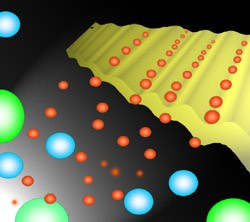Manipulating Nanoparticles

Focused light beams called optical tweezers excel at trapping and moving micron-sized objects, but nanometer-scale particles generally slip through their grasp. Now researchers calculate that a laser tuned to resonate with the internal energy levels of semiconductor nanoparticles could strengthen its grip up to 100,000 times. A previous study had suggested a similar but much less drastic enhancement. The paper, appearing in the 7 February print issue of PRL, points the way toward size- and shape-selective sorting of building blocks for efficient nano-patterned materials.
Separating minuscule objects by size and shape is a surprisingly important task. The speed with which fragments of chopped-up DNA molecules can be sorted determines the speed of genetic sequencing. In materials science, the ability to precisely select and orient particles would allow researchers to fashion substances that respond to a narrow range of light frequencies. Aside from some success trapping metallic particles, researchers have yet to master the manipulation of objects that are tens of nanometers across.
In optical tweezing, the electric field of a laser is concentrated at the focal point and weaker elsewhere, and the differential nudges the particle to the center of the beam. Even uncharged particles feel the gradient because the field’s oscillation distorts, or “polarizes,” their electron clouds, which amplifies the effect. Particles much smaller than the wavelength of the light are affected very weakly, however. Researchers have envisioned getting around this difficulty by tuning a laser’s frequency to match–or resonate with–the energy difference between a pair of the particle’s electron states.
Now Takuya Iida and Hajime Ishihara of Osaka University have calculated that 10-nanometer particles of zinc oxide or copper chloride would experience 10,000 to 100,000 times more force from a resonant beam than from a non-resonant one. They imagine pushing the molecular-scale particle with pure radiation pressure–like blasting an underwater bead with a fluid jet–rather than trapping it at a fixed focal point. The enhancement occurs because resonance exaggerates the particle’s polarization, which causes it to scatter more photons. If two counter-propagating lasers were set up to create a standing wave, the resulting electric field gradient would direct particles toward the wave’s nodes. Another recent study of the effect of nearly resonant light on small particles had predicted a 50-fold increase in the trapping force [1]
The Osaka group found that the peak force depends strongly on the individual object’s size and shape. Ishihara says the result opens the way for a new optical method of sorting nanoparticles. Propagating laser light could push objects of a certain size out from a mixed group, and a standing beam could then arrange them in a periodic pattern.
David Grier of the University of Chicago notes that researchers have been pondering the resonance trick for nearly a decade but is impressed by the possibility of a 10,000-fold enhancement. “That’s an extraordinary prediction and one that certainly can be tested.” Arrays of tuned tweezers could be a promising avenue for sorting biological molecules, judging from his own work, he says [2]
Philippe Guyot-Sionnest, also at the University of Chicago, believes the resonant light would burn up nanoparticles. Ishihara says this is true of larger particles, but says his team’s work shows that for some particles at least, heat is radiated away fast enough to prevent meltdown.
–JR Minkel
JR Minkel is a freelance science writer in New York City.
References
- R. R. Agayan, et al., Appl. Opt. 4, 2318 (2002).
- P. T. Korda, et al., Phys. Rev. Lett. 89, 128301 (2002)


